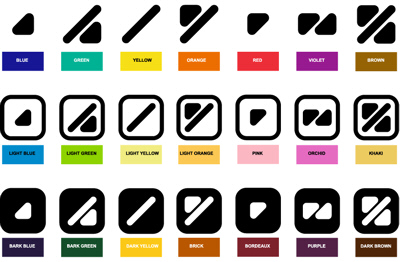The designer Miguel Neiva developed a color coding system called ColorAdd which shall help colorblind people around the world. Simple and easy with many applications. Let’s have a closer look at it.

The system is based on three basic color shapes representing the primary colors blue, yellow, red and two forms for black and white. While mixing those basic graphics like you would mix colors themselves this results in a list of 21 basic colors including lighter (mixing in white) and darker (mixing in black) shades.

This is it. Some more shapes for grey, silver and gold, but nothing else. That’s the whole ColorAdd system. At the first glance this is really simple and easy.
The designer claims that you don’t really have to memorize all those shapes as it works like mixing real colors. If you know the basic shapes you’re all set. In a way that’s true. But as I’m not that good on mixing colors—remember I am colorblind—I have to think about it twice if I’m right with my color mixture guess.
- Simple: Yes. But somewhere you have to explain the system in my language as the symbols can’t easily be associated with the right colors.
- Intuitively: No. Why don’t you use some sort of symbols which everybody associates with a certain color like fire, water and sun?
- Nice design: Yes. Yes I like it. Simple shapes, they are nice to look at.
- Robust usage: No. Hold some of them upside down and you will get the wrong color.
But the most important question to answer is: Can this color coding system be an added value for color blind people? This is what the designer claims and what it is actually all about. I don’t think so. Here are a few examples in my everyday life to support my point of view:
- The banana couldn’t change such a shape if it turns ripe. A big issue for me.
- Red/green led lights often already include some icon to show you something. So you can’t enhance them with another one and I’ll never know if it’s red or green.
- Ok, I would know if my shirt is blue or green. But I’m still not sure if it matches my purple tie or red trousers.
- And in most cases already now the manufacturers could add some sort of icon or pattern to help colorblind users in many situations. But they don’t do it and such a color code wouldn’t be easier to decipher than some simple icons.
Nice but unusable for me. I would be very glad if I get proven wrong in the future, if ColorAdd starts to get used and enhances my life in some way I can’t see yet.

I think this could be useful in color selection chart and in mouse-over help in word, acrobat reader or other tools. I can’t differentiate red from black when there is not a lot of surface. When my colleagues send me a document with sections in red to indicate something about these, I can’t see it. Most of then now use an other color or change the back color. If Acrobat reader could show me the symbol, I would have been able to know the color. But the best use would be in color selection panels. I could know the color rapidly without waiting for the name of the color to show in the mouse over.
First of all, thank you for your interest.
I am the author of this project and read carefully your comments.
Good to know that we are all moving towards the same side, allowed and to make inclusion a reality for more people.
Of the four questions that you set in your blog, 3 of them only time will tell the answer. We are always working to improve this project.
Regarding the question of the orientation of the symbols. In studies and trials, concluded that few situations where this problem arises – is the symbol that represents the color of an information element, it always appears with more information (with guidance set). However, the solution is provided in the book of graphic standards for this project.
Your question is the question of symbols a lot to see reversed – the references are the numbers are presented in balls snoker. This project is aimed at all colorblind people (regardless of cultural background, age, knowledge, etc …), which attempted to create the simplest element to facilitate the store.
Thanks again for your interest and I am available to answer more questions.
Martin, thanks for your input. You are right, there are some good areas of applications on computers.
Miguel, it’s a pleasure to hear from you. I’m really looking forward to see some really good applications of your system. I would be one of the first to adopt it if it really helps in my every day life. Thanks.
dor1.txt;10;15
Thank you for calling out this project. I came across it when it was first posted and thought it would provide little benefit for all the reasons you highlighted. Thank you for making me feel like I’m not alone in understanding the code’s purpose. I’d rather have words explaining the colors (this tie is red and grey) instead of arbitrary symbols that are based on understanding color in the first place.
Now I can say that the ColorADD® system started (March 2010) to be used by Portuguese companies with an international dimension.
was first necessary to secure the acceptance and recognition of this system throughout the world community. 2009 was the year of raising awareness of the ColorADD®system. You are now ready to be adopted.
I am very interested in making contact with international companies and organizations interested in implementing the system in their products, where color is a factor of identification, guidance and choice.
is undoubtedly a tool of inclusion and a strong argument for social responsibility and sustainability.
my contact is coloradd@gmail.com or info@coloradd.com
In FaceBooK:ColorADD